ESP RENAULT TWINGO 2012 2.G User Guide
[x] Cancel search | Manufacturer: RENAULT, Model Year: 2012, Model line: TWINGO, Model: RENAULT TWINGO 2012 2.GPages: 220, PDF Size: 6.73 MB
Page 83 of 220
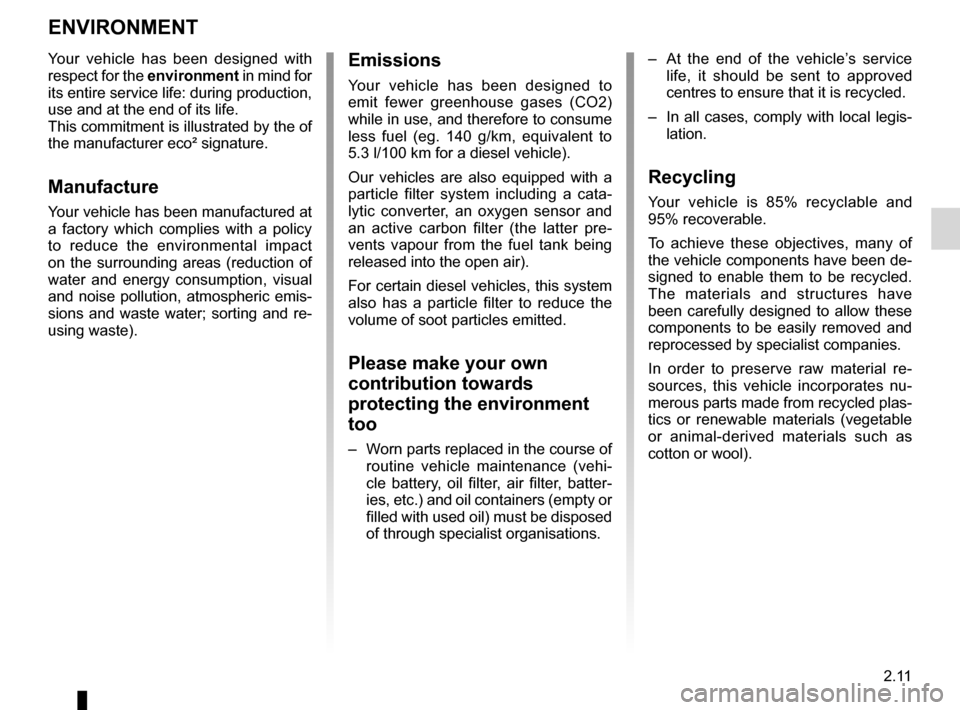
environment .......................................... (up to the end of the DU)
2.11
ENG_UD25716_1
Environnement (sans marque) (X44 - X45 - X77 - X81 - X85 - X90 - X91 - X83 - X61 - TEST - X95 - J95 - R95 - F90 Ph2 - X33 - X47 - X43 - X38 - H79 - X62 - X32 - X09 -
ENG_NU_952-4_X44_Renault_2
Environment
eNvIRoNMeNt
emissions
Your vehicle has been designed to
emit fewer greenhouse gases (CO2)
while in use, and therefore to consume
less fuel (eg. 140 g/km, equivalent to
5.3 l/100 km for a diesel vehicle).
Our vehicles are also equipped with a
particle filter system including a cata -
lytic converter, an oxygen sensor and
an active carbon filter (the latter pre -
vents vapour from the fuel tank being
released into the open air).
For certain diesel vehicles, this system
also has a particle filter to reduce the
volume of soot particles emitted.
Please make your own
contribution towards
protecting the environment
too
– Worn parts replaced in the course of
routine vehicle maintenance (vehi -
cle battery, oil filter, air filter, batter -
ies, etc.) and oil containers (empty or
filled with used oil) must be disposed
of through specialist organisations. –
At the end of the vehicle’s service
life, it should be sent to approved
centres to ensure that it is recycled.
– In all cases, comply with local legis -
lation.
Recycling
Your vehicle is 85% recyclable and
95% recoverable.
To achieve these objectives, many of
the vehicle components have been de-
signed to enable them to be recycled.
The materials and structures have
been carefully designed to allow these
components to be easily removed and
reprocessed by specialist companies.
In order to preserve raw material re -
sources, this vehicle incorporates nu -
merous parts made from recycled plas-
tics or renewable materials (vegetable
or animal-derived materials such as
cotton or wool).
Your vehicle has been designed with
respect for the
environment in mind for
its entire service life: during production,
use and at the end of its life.
This commitment is illustrated by the of
the manufacturer eco² signature.Manufacture
Your vehicle has been manufactured at
a factory which complies with a policy
to reduce the environmental impact
on the surrounding areas (reduction of
water and energy consumption, visual
and noise pollution, atmospheric emis-
sions and waste water; sorting and re-
using waste).
Page 84 of 220
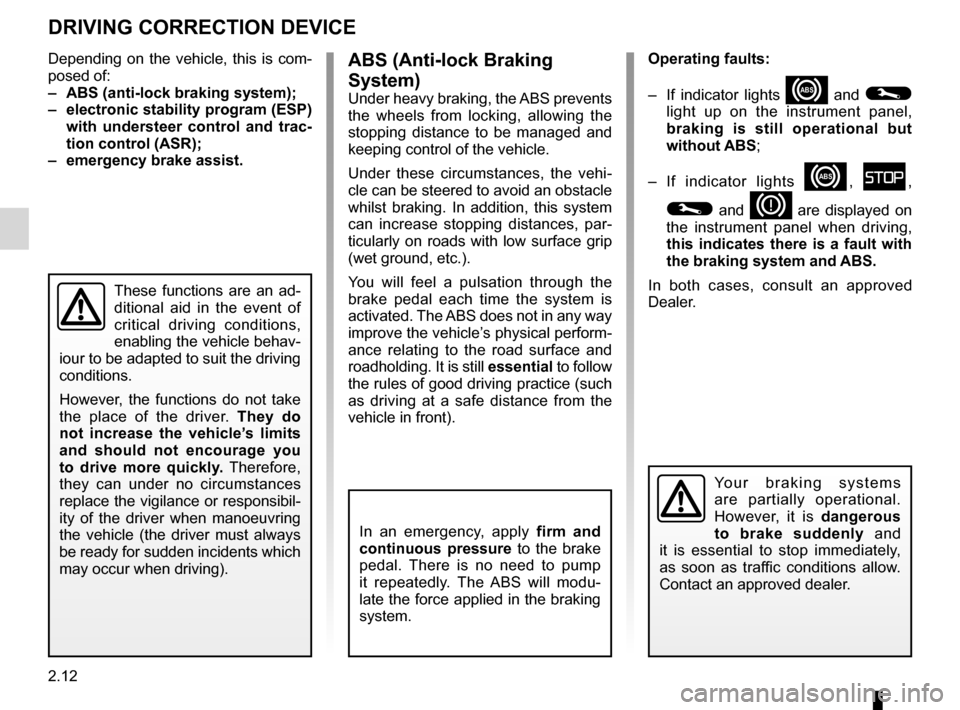
ABS ...................................................... (up to the end of the DU)
anti-lock braking system: ABS ..............(up to the end of the DU)
ESP: Electronic Stability Program ........ (up to the end of the DU)
ASR (traction control) ........................... (up to the end of the DU)
traction control: ASR .............................(up to the end of the DU)
Electronic Stability Program: ESP ........ (up to the end of the DU)
emergency brake assist ........................(up to the end of the DU)
emergency braking ............................... (up to the end of the DU)
traction control: ASR .............................................. (current page)
driving ................................................... (up to the end of the DU)
2.12
ENG_UD25058_2
Dispositifs de correction de conduite (X44 - Renault)
ENG_NU_952-4_X44_Renault_2
Jaune NoirNoir texte
Driving correction devices
DRIvING coRRectIoN DevIce
Depending on the vehicle, this is com-
posed of:
– ABS (anti-lock braking system);
– electronic stability program (eSP)
with understeer control and trac -
tion control (ASR);
– emergency brake assist.
In an emergency, apply firm and
continuous pressure to the brake
pedal. There is no need to pump
it repeatedly. The ABS will modu -
late the force applied in the braking
system.
These functions are an ad-
ditional aid in the event of
critical driving conditions,
enabling the vehicle behav -
iour to be adapted to suit the driving
conditions.
However, the functions do not take
the place of the driver. they do
not increase the vehicle’s limits
and should not encourage you
to drive more quickly. Therefore,
they can under no circumstances
replace the vigilance or responsibil -
ity of the driver when manoeuvring
the vehicle (the driver must always
be ready for sudden incidents which
may occur when driving).
Yo u r b r a k i n g s y s t e m s
are partially operational.
However, it is dangerous
to brake suddenly and
it is essential to stop immediately,
as soon as traffic conditions allow.
Contact an approved dealer.
operating faults:
– If indicator lights
x and © light up on the instrument panel,
braking is still operational but
without ABS;
– If indicator lights
x, û,
© and D are displayed on
the instrument panel when driving,
this indicates there is a fault with
the braking system and ABS.
In both cases, consult an approved
Dealer.
ABS (Anti-lock Braking
System)
Under heavy braking, the ABS prevents
the wheels from locking, allowing the
stopping distance to be managed and
keeping control of the vehicle.
Under these circumstances, the vehi -
cle can be steered to avoid an obstacle
whilst braking. In addition, this system
can increase stopping distances, par -
ticularly on roads with low surface grip
(wet ground, etc.).
You will feel a pulsation through the
brake pedal each time the system is
activated. The ABS does not in any way
improve the vehicle’s physical perform-
ance relating to the road surface and
roadholding. It is still essential to follow
the rules of good driving practice (such
as driving at a safe distance from the
vehicle in front).
Page 85 of 220
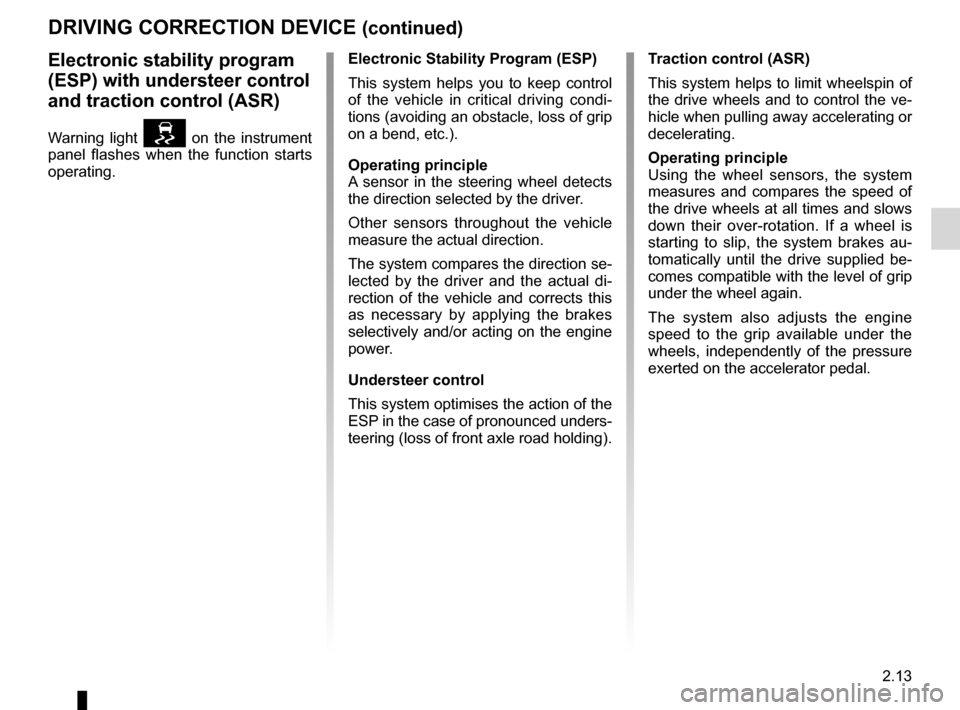
JauneNoirNoir texte
2.13
ENG_UD25058_2
Dispositifs de correction de conduite (X44 - Renault)
ENG_NU_952-4_X44_Renault_2
DRIvING coRRectIoN DevIce (continued)
electronic stability program
(eSP) with understeer control
and traction control (ASR)
Warning light on the instrument
panel flashes when the function starts
operating. electronic Stability Program (eSP)
This system helps you to keep control
of the vehicle in critical driving condi
-
tions (avoiding an obstacle, loss of grip
on a bend, etc.).
operating principle
A sensor in the steering wheel detects
the direction selected by the driver.
Other sensors throughout the vehicle
measure the actual direction.
The system compares the direction se-
lected by the driver and the actual di -
rection of the vehicle and corrects this
as necessary by applying the brakes
selectively and/or acting on the engine
power.
Understeer control
This system optimises the action of the
ESP in the case of pronounced unders-
teering (loss of front axle road holding). t
raction control (ASR)
This system helps to limit wheelspin of
the drive wheels and to control the ve-
hicle when pulling away accelerating or
decelerating.
operating principle
Using the wheel sensors, the system
measures and compares the speed of
the drive wheels at all times and slows
down their over-rotation. If a wheel is
starting to slip, the system brakes au -
tomatically until the drive supplied be -
comes compatible with the level of grip
under the wheel again.
The system also adjusts the engine
speed to the grip available under the
wheels, independently of the pressure
exerted on the accelerator pedal.
Page 86 of 220
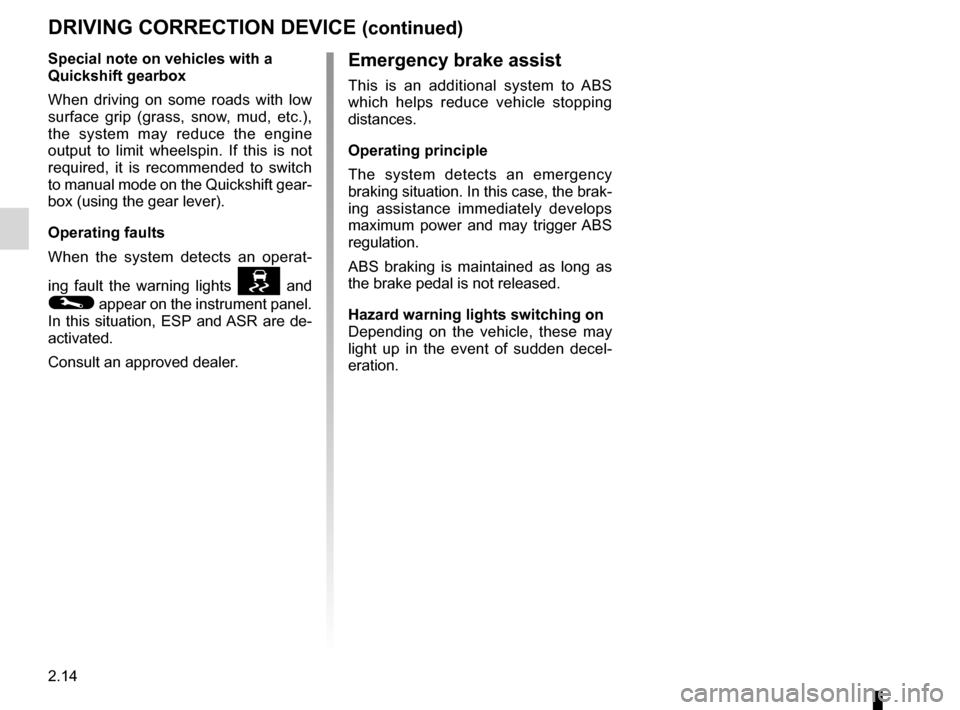
2.14
ENG_UD25058_2
Dispositifs de correction de conduite (X44 - Renault)
ENG_NU_952-4_X44_Renault_2
emergency brake assist
This is an additional system to ABS
which helps reduce vehicle stopping
distances.
operating principle
The system detects an emergency
braking situation. In this case, the brak-
ing assistance immediately develops
maximum power and may trigger ABS
regulation.
ABS braking is maintained as long as
the brake pedal is not released.
hazard warning lights switching on
Depending on the vehicle, these may
light up in the event of sudden decel -
eration.
DRIvING coRRectIoN DevIce (continued)
Special note on vehicles with a
Quickshift gearbox
When driving on some roads with low
surface grip (grass, snow, mud, etc.),
the system may reduce the engine
output to limit wheelspin. If this is not
required, it is recommended to switch
to manual mode on the Quickshift gear-
box (using the gear lever).
operating faults
When the system detects an operat -
ing fault the warning lights
and
© appear on the instrument panel.
In this situation, ESP and ASR are de-
activated.
Consult an approved dealer.
Page 90 of 220
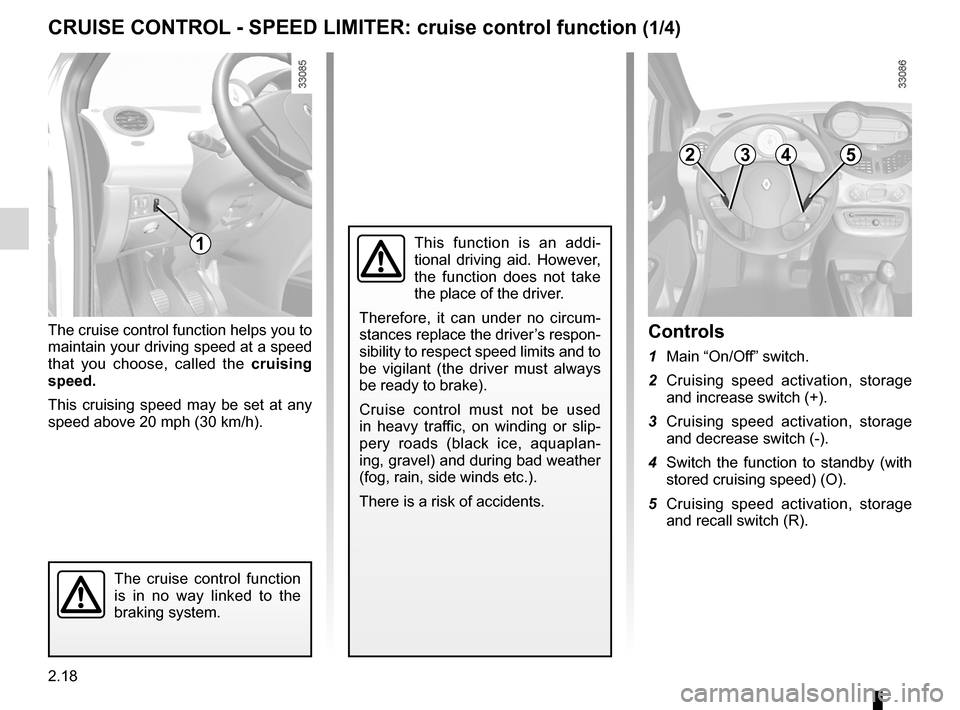
cruise control ........................................ (up to the end of the DU)
cruise control-speed limiter................... (up to the end of the DU)
driving ................................................... (up to the end of the DU)
2.18
ENG_UD24754_4
Régulateur-limiteur de vitesses : fonction régulateur (X44 - Renault)
ENG_NU_952-4_X44_Renault_2
Jaune NoirNoir texte
Cruise control - speed limiter: cruise control function
cRUISe coNtRol - SPeeD lIMIteR: cruise control function (1/4)
The cruise control function helps you to
maintain your driving speed at a speed
that you choose, called the cruising
speed.
This cruising speed may be set at any
speed above 20 mph (30 km/h).
The cruise control function
is in no way linked to the
braking system.
This function is an addi -
tional driving aid. However,
the function does not take
the place of the driver.
Therefore, it can under no circum -
stances replace the driver’s respon-
sibility to respect speed limits and to
be vigilant (the driver must always
be ready to brake).
Cruise control must not be used
in heavy traffic, on winding or slip -
pery roads (black ice, aquaplan -
ing, gravel) and during bad weather
(fog, rain, side winds etc.).
There is a risk of accidents.
controls
1 Main “On/Off” switch.
2 Cruising speed activation, storage
and increase switch (+).
3 Cruising speed activation, storage
and decrease switch (-).
4 Switch the function to standby (with
stored cruising speed) (O).
5 Cruising speed activation, storage
and recall switch (R).
1
2345
Page 105 of 220
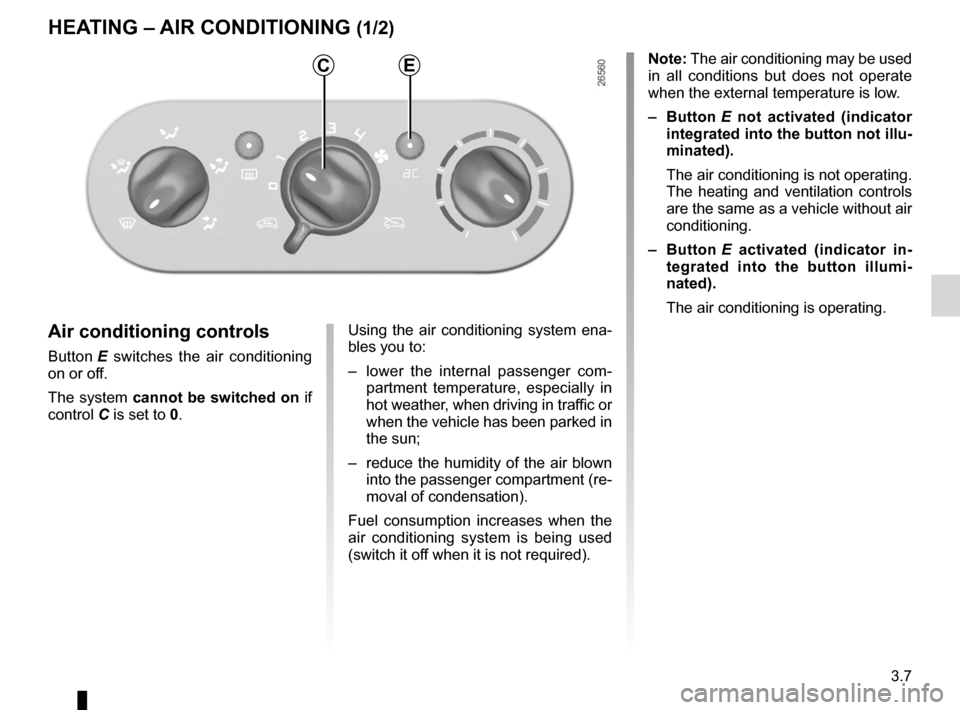
heating system ..................................... (up to the end of the DU)
ventilation ............................................. (up to the end of the DU)
air conditioning ..................................... (up to the end of the DU)
air conditioning ..................................... (up to the end of the DU)
heating and air conditioning system ..... (up to the end of the DU)
temperature regulation ......................... (up to the end of the DU)
3.7
ENG_UD20167_4
Chauffage / air conditionné (X44 - Renault)
ENG_NU_952-4_X44_Renault_3
Heating – air conditioning
hEATINg – AIR CoNDITIoNINg (1/2)
Air conditioning controls
Button E switches the air conditioning
on or off.
The system cannot be switched on if
control C is set to 0.
Using the air conditioning system ena-
bles you to:
– lower the internal passenger com -
partment temperature, especially in
hot weather, when driving in traffic or
when the vehicle has been parked in
the sun;
– reduce the humidity of the air blown
into the passenger compartment (re-
moval of condensation).
Fuel consumption increases when the
air conditioning system is being used
(switch it off when it is not required). Note: The air conditioning may be used
in all conditions but does not operate
when the external temperature is low.
–
Button E not activated (indicator
integrated into the button not illu -
minated).
The air conditioning is not operating.
The heating and ventilation controls
are the same as a vehicle without air
conditioning.
– Button E activated (indicator in -
tegrated into the button illumi -
nated).
The air conditioning is operating.
CE
Page 116 of 220
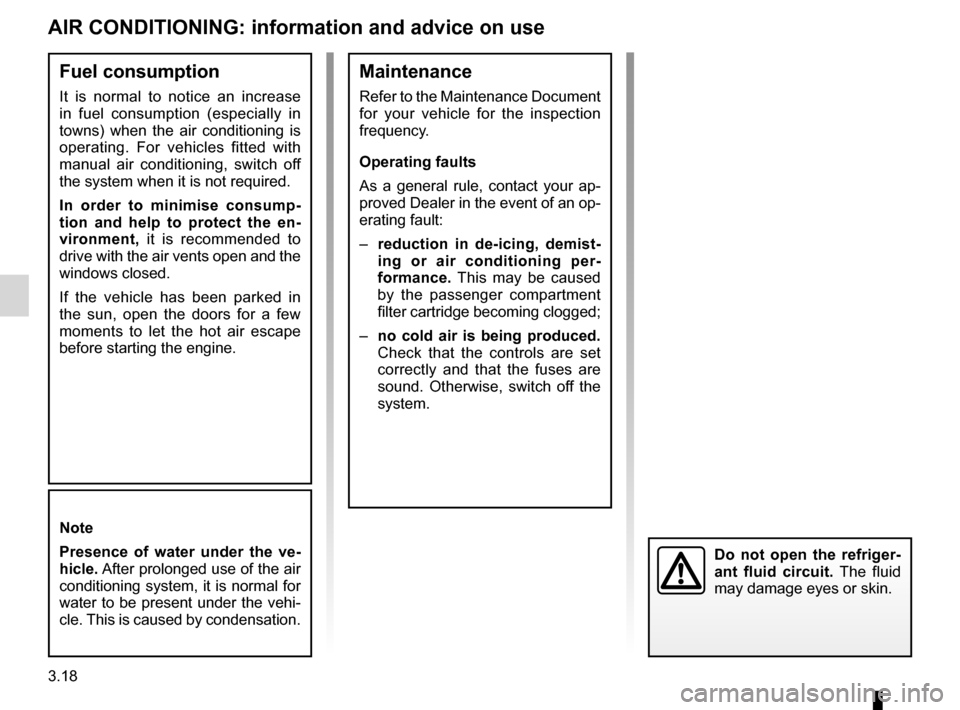
heating system ..................................... (up to the end of the DU)
air conditioning ..................................... (up to the end of the DU)
ventilation ............................................. (up to the end of the DU)
3.18
ENG_UD11090_2
Air conditionné : informations et conseils utilisation (X44 - Renaul\
t)
ENG_NU_952-4_X44_Renault_3
Air conditioning: information and advice on use
AIR CoNDITIoNINg: information and advice on use
Fuel consumption
It is normal to notice an increase
in fuel consumption (especially in
towns) when the air conditioning is
operating. For vehicles fitted with
manual air conditioning, switch off
the system when it is not required.
In order to minimise consump -
tion and help to protect the en -
vironment, it is recommended to
drive with the air vents open and the
windows closed.
If the vehicle has been parked in
the sun, open the doors for a few
moments to let the hot air escape
before starting the engine.
Maintenance
Refer to the Maintenance Document
for your vehicle for the inspection
frequency.
operating faults
As a general rule, contact your ap-
proved Dealer in the event of an op-
erating fault:
– reduction in de-icing, demist -
ing or air conditioning per -
formance. This may be caused
by the passenger compartment
filter cartridge becoming clogged;
– no cold air is being produced.
Check that the controls are set
correctly and that the fuses are
sound. Otherwise, switch off the
system.
Note
Presence of water under the ve -
hicle. After prolonged use of the air
conditioning system, it is normal for
water to be present under the vehi-
cle. This is caused by condensation.
Do not open the refriger -
ant fluid circuit. The fluid
may damage eyes or skin.
Page 118 of 220
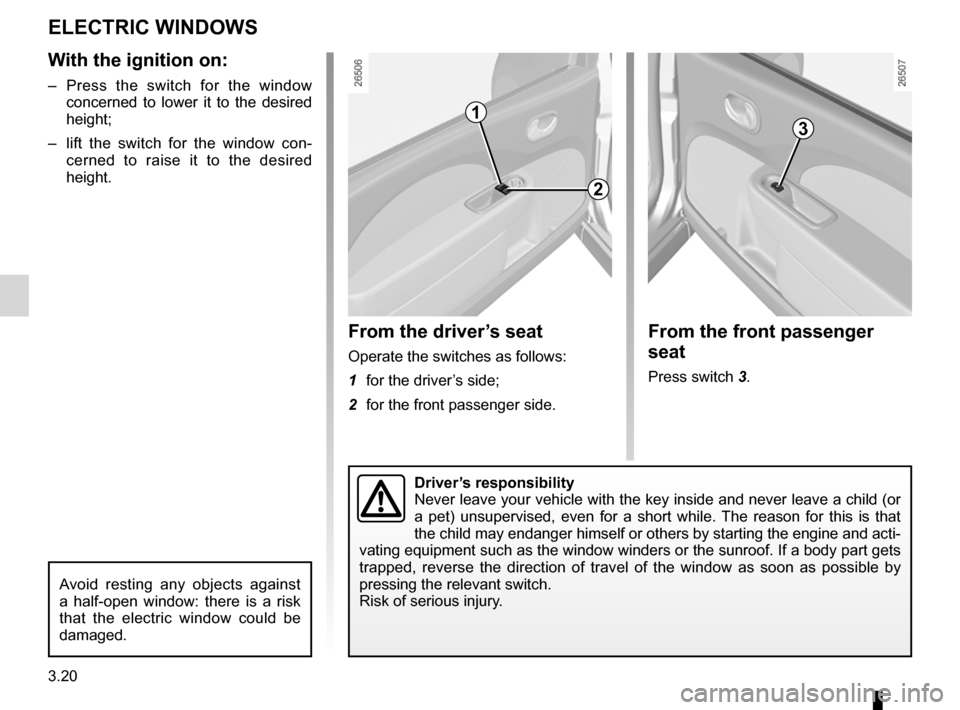
electric windows ................................... (up to the end of the DU)
3.20
ENG_UD11091_2
Lève-vitres électriques (X44 - Renault)
ENG_NU_952-4_X44_Renault_3
Electric windows
ElECTRIC WINDoWS
With the ignition on:
– Press the switch for the window
concerned to lower it to the desired
height;
– lift the switch for the window con -
cerned to raise it to the desired
height.
From the driver’s seat
Operate the switches as follows:
1 for the driver’s side;
2 for the front passenger side.
From the front passenger
seat
Press switch 3.
Driver’s responsibility
Never leave your vehicle with the key inside and never leave a child (or
a pet) unsupervised, even for a short while. The reason for this is that
the child may endanger himself or others by starting the engine and acti-
vating equipment such as the window winders or the sunroof. If a body part gets
trapped, reverse the direction of travel of the window as soon as possible by
pressing the relevant switch.
Risk of serious injury.
1
2
3
Avoid resting any objects against
a half-open window: there is a risk
that the electric window could be
damaged.
Page 119 of 220
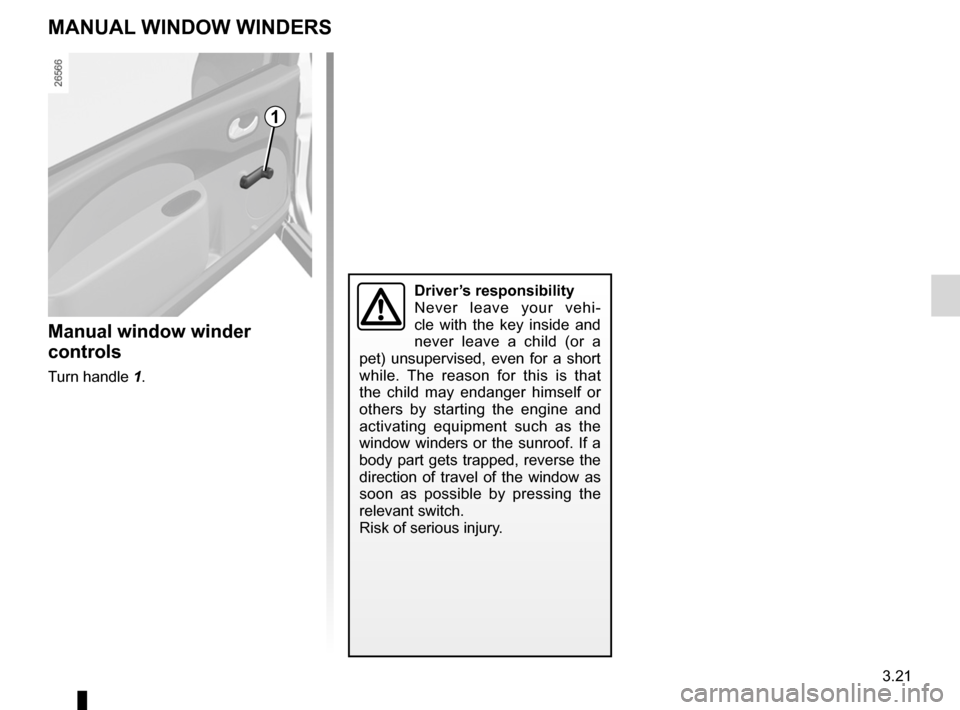
3.21
ENG_UD22506_5
Lève-vitres électriques impulsionnels / Lève-vitres manuels (X\
44 - Renault)
ENG_NU_952-4_X44_Renault_3
MANuAl WINDoW WINDERS
Manual window winder
controls
Turn handle 1.
Driver’s responsibility
Never leave your vehi -
cle with the key inside and
never leave a child (or a
pet) unsupervised, even for a short
while. The reason for this is that
the child may endanger himself or
others by starting the engine and
activating equipment such as the
window winders or the sunroof. If a
body part gets trapped, reverse the
direction of travel of the window as
soon as possible by pressing the
relevant switch.
Risk of serious injury.
1
Page 121 of 220
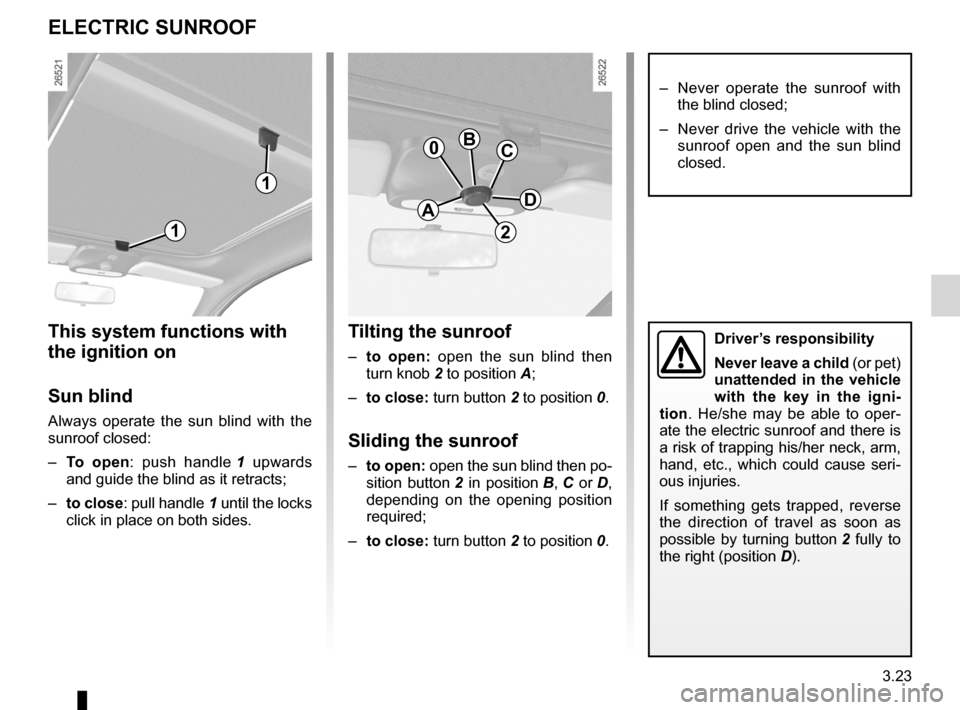
sunroof.................................................. (up to the end of the DU)
3.23
ENG_UD4077_2
Toit ouvrant à commande électrique (X44 - Renault)
ENG_NU_952-4_X44_Renault_3
Toit ouvrant à commande électrique
ElECTRIC SuNRooF
This system functions with
the ignition on
Sun blind
Always operate the sun blind with the
sunroof closed:
– To open : push handle 1 upwards
and guide the blind as it retracts;
– to close: pull handle 1 until the locks
click in place on both sides.
Tilting the sunroof
– to open: open the sun blind then
turn knob 2 to position A;
– to close: turn button 2 to position 0.
Sliding the sunroof
– to open: open the sun blind then po-
sition button 2 in position B , C or D ,
depending on the opening position
required;
– to close: turn button 2 to position 0.
– Never operate the sunroof with
the blind closed;
– Never drive the vehicle with the
sunroof open and the sun blind
closed.
Driver’s responsibility
Never leave a child (or pet)
unattended in the vehicle
with the key in the igni -
tion . He/she may be able to oper -
ate the electric sunroof and there is
a risk of trapping his/her neck, arm,
hand, etc., which could cause seri -
ous injuries.
If something gets trapped, reverse
the direction of travel as soon as
possible by turning button 2 fully to
the right (position D).
1
1
A
0BC
D
2